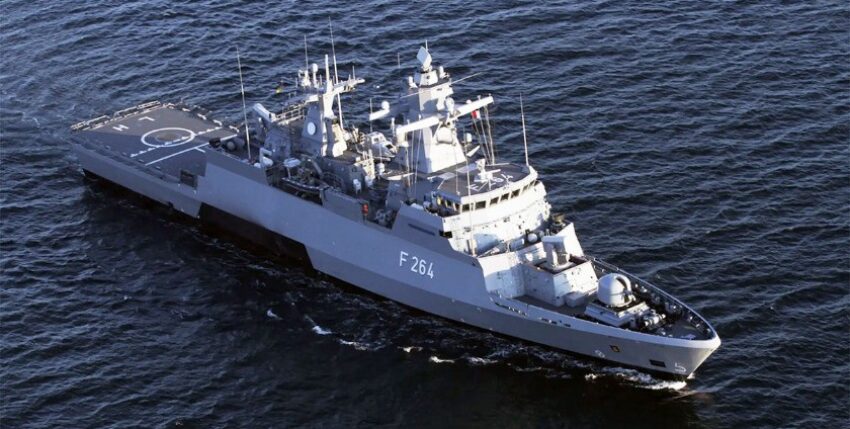In mid-February - six days before the Russian invasion of Ukraine - we asked ourselves whether the German government was waking up from its slumber in view of the threat on Europe's eastern flank with regard to the defence force and its expenditure. We wrote specifically in an article:
The media image is dominated by the Russian combat vehicles deployed in a horseshoe shape around eastern Ukraine. [...] Is the current threat posed by Moscow enough to awaken Berlin from its slumber, or will it fall back into old patterns once the crisis is over? How can these security requirements for Germany and Europe be financed against the backdrop of an overstretched defence budget and a strained federal budget? And are these efforts organisationally and fiscally feasible in view of the dramatic demographic development?
In the upcoming budget preparation, Berlin will show how seriously it takes Moscow's sabre-rattling in eastern Ukraine and its own military and security policy capabilities. [...]Talking about what needs to be done now also reveals what has not been done in recent years.
Security is precaution - Commentary on the Russian-Ukrainian crisis. Blog #meerverstehen, 18/02/2022.
Less sparkling wine?
We now know more - including that Chancellor Olaf Scholz is planning a special fund of €100 billion for the Bundeswehr. We will find out what the special fund will ultimately look like in budgetary terms in mid-May, when the budget law is due to be passed by the Bundestag. What the politically organised "shopping list" of the dimensions (formerly the armed forces) will look like at the end of the day is currently an ongoing process in Berlin. Hans-Uwe Mergener has thankfully summarised the wishes and requirements that could arise from the perspective of the German Navy in a current contribution explained.
There is still a lot of water flowing through the Kiel Canal until the politicians decide and the industry delivers the ships and boats ordered. Until then, what is the status of the German Navy's existing and incoming units? We read about the two projects K 130 and F 125 in the 14th Armaments Report of the BMVg:
Corvette class 130, 2nd batch
Range of services
The Class 130 corvettes are a key component of the navy's crisis response operations. Their main tasks are reconnaissance of the surface situation and maritime target engagement. The operational spectrum ranges from peacetime presence and military crisis management tasks to combat in marginal seas and weapons effects on land. The project will be used to procure a further five Class 130 corvette boats.
Significant changes
Boats 6 to 8 are being fitted out in Hamburg. In terms of shipbuilding, the boats are on schedule. The twelve-month "design freeze" for the deployment system requested by the K 130 consortium in September 2020 was implemented in order to ensure the delivery of the boats and the deployment/operational support centre with full functionalities of the deployment system, combined with a delivery delay of two months for boats 6 and 7.
An intensification of the existing risks to the deployment system is possible. The contractual implementation of the delay through the integration of the new framework schedule into an amendment to the construction contract is still pending. In September 2021, the further procedure and the corresponding proposals for the technical solutions were presented as part of a project review. These are now being analysed in detail after the concepts presented in March 2021 for integrating the deployment system and mitigating possible delivery delays in the area of hardware were rejected by the contracting authority (öAG) due to unacceptable timelines.
Project overview
- Development measured against the first parliamentary referral:
Deviation from the next milestone "start of delivery": +9 months in 2023
Deviation from the current estimate: € +311 million (+13 per cent) - Development measured against the current contractual situation:
Deviation from the next milestone "start of delivery": +2 months in 2023
Share of performance improvement/change in the above-mentioned deviation: +€191 million (+61 per cent)
Status & development of the project
The K 130 2nd lot project is currently on schedule and within budget in accordance with the contractual basis. The close working relationship between öAG and the K 130 consortium with on-site project management at the headquarters of the K 130 consortium is having a very positive effect on project management. Furthermore, there are signs of a delay due to a delay in performance on the part of the FüWES consortium (KoFü) as part of the integration of the deployment system. It will not be possible to specify this precisely until the end of the fourth quarter of 2021 at the earliest. The öAG's obligations to cooperate, including in the review and approval of the technical documentation, require considerable human resources, which can only be provided in a project-compatible manner with the help of external support. The centre of gravity of the project has now shifted from Lemwerder to Hamburg, with three of the five boats currently being equipped.
Overall planning categorisation
The Class 130 corvettes are an important operational asset in the context of marginal sea warfare. They are used both to combat sea targets and to provide joint tactical fire support for forces ashore. The additional procurement of five corvettes will help to reduce the individual operational loads of all corvettes and subsequently of the navy. In addition, the greatest possible degree of structural uniformity will reduce the technical, personnel and organisational costs in the areas of training and infrastructure ashore.
In view of the current funding lines, the decision to procure a further five corvettes (boats 11-15 to ensure operational availability while at the same time utilising the first batch) cannot be financed for the time being. In order to fulfil the national ambition of a total of ten corvettes, options for achieving this are now being examined as part of an overall planning consideration, which at the same time do justice to the uninterrupted use of the design status of the current production line of the 2nd batch.
Defence & alliance policy aspects & developments
German naval forces protect the territorial integrity of Germany and its allies. The ability to act at sea is a prerequisite for engagement in crisis management by seagoing forces and for ensuring secure supply routes. In addition, the Class 130 corvette is a key component of the Bundeswehr's international crisis management.
Defence industry aspects & developments
The follow-up procurement K 130 2nd lot expands the Navy's capability portfolio in terms of quantity and, to a limited extent, quality as part of the elimination of obsolescence. By commissioning the K 130 2nd lot, the defence capabilities in national surface warship construction have been consolidated as part of the necessary renewal of the fleet.
Effects on operational readiness
The key to material operational readiness lies in the timely establishment of supply readiness and the implementation of all necessary measures for the accreditation of the IT systems of the entire K 130 class. Failure to establish supply readiness, i.e. permanently restricted logistical operability, will foreseeably have a negative impact on material operational readiness and, like the lack of or restricted accreditation of the IT systems, will significantly restrict the operational usability of the corvettes.
Frigate class 125
Range of services
The Class 125 frigate (F 125) is designed to meet the changing operational requirements of the present and the future. Among other things, the F 125 should be able to carry out worldwide and long-term missions. The main tasks are to carry out maritime stabilisation operations (low and medium intensity), provide tactical fire support from sea to shore, act against asymmetric threats at sea, provide command and control capability at commander level (Commander Task Group [CTG]) and support special forces operations or specialised forces.
Due to the required intensive utilisation (i.e. two years in service; 5,000 operating hours per year; worldwide deployment; operational maintenance period standard [BEPN] 68 months; implementation of a two-crew concept), the maintenance of the ship and the equipment, combined with the requirement for a small crew size, is of great importance and new technical concepts are therefore also required in the area of platform design.
Significant changes
The first ship, the frigate Baden-Württemberg (BWG), began its maintenance work on 6 April 2021 after its first phase of use. This ends on 26/08/2022.
The second ship, frigate North Rhine-Westphalia (NRW), was commissioned on 10 June 2020 and ship three, frigate Saxony-Anhalt (SAH), on 17 May 2021.
The delivery date announced by the industry for the fourth and final ship, the frigate Rheinland-Pfalz (RHL), in mid-October 2021 had to be postponed due to the fact that the proofs of functionality had not been completed on several occasions. Delivery in December 2021 is primarily dependent on the fulfilment of the proofs of function, in particular the operational system, as well as a contractual agreement on services still owed and any remaining performance deficits.
Project overview
- Development measured against the first parliamentary referral:
Deviation from the next "IOC" milestone: +70 months in 2021
Deviation from the current estimate: + € 1.117 billion (+51 per cent) - Development measured against the current contractual situation:
Deviation from the next "IOC" milestone: +15 months in 2021
Share of performance improvement/change in the above-mentioned deviation: + € 355 million (+32 per cent)
Status & development of the project
The delivery of ship 4, which is expected in December 2021, is highly risky due to outstanding evidence in the deployment system, the follow-up and rectification of all outstanding technical, commercial and contractual performance deficits as well as still outstanding contracts to establish operational readiness.
The scheduling, which is dominated by the block formation of measures, foreseeably reduces the possibilities of qualifying crews for deployment purposes.
Overall planning categorisation
With the acceptance of the fourth and final ship, planned for this year, the capability build-up of the weapon system is progressing steadily. Due to the remaining limitations in the operational system and information security as well as the lack of operational testing (127mm artillery and missile firing), operational use will not be possible until 2023. From a planning perspective, the prompt elimination of these deficits has the highest priority in order to make the four units operationally available as quickly as possible.
Defence & alliance policy aspects & developments
Naval forces make a permanent contribution to maritime security in national and multinational organisations. The Class 125 frigate provides greater room for manoeuvre in terms of defence policy to counter crises and conflicts worldwide at their point of origin in order to prevent further escalation at an early stage. In addition, Germany is making an essential and visible contribution to the permanent NATO naval organisations with the F 125.
Defence industry aspects & developments
In addition to expanding the navy's range of capabilities, the F 125 offers the opportunity to demonstrate the technological capabilities of the German shipbuilding industry. Challenges exist for ship-based IT systems and their accreditation. The ongoing digitalisation of naval shipbuilding is creating a new development focus for the companies involved in the marketing of their products and their commercial success.
Effects on operational readiness
The key to material operational readiness lies in establishing supply readiness and implementing all necessary measures to accredit the IT systems of the Class 125 frigates. Failure to establish supply readiness, i.e. permanently restricted logistical operability, will foreseeably have a negative impact on material operational readiness and, like a lack of or restricted accreditation of the IT systems, will restrict the operational usability of the frigates.








